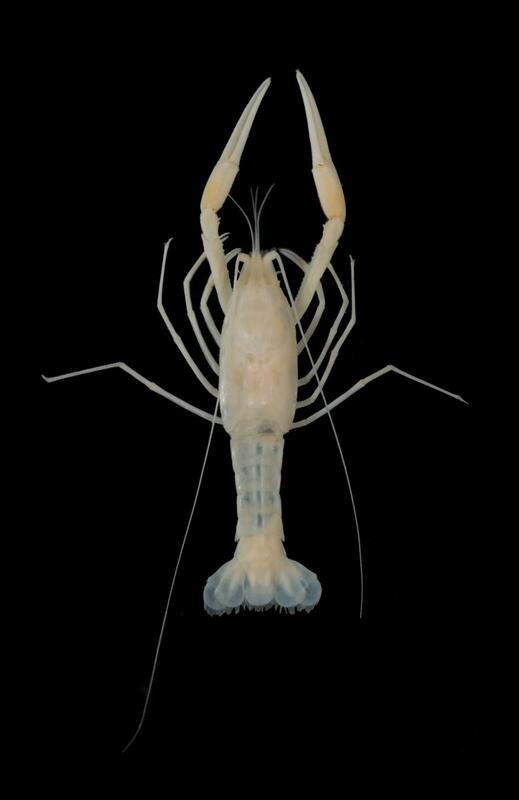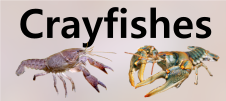







Loading profile. Please wait . . .
Cambarus cryptodytes Hobbs, 1941
Dougherty Plain Cave Crayfish




Federal Protection: No US federal protection
State Protection: Threatened
Global Rank: G2G3
State Rank: S2
Element Locations Tracked in Biotics: Yes
SWAP 2015 Species of Greatest Conservation Need (SGCN): Yes
SWAP 2025 Species of Greatest Conservation Need (SGCN): Yes
2025 SGCN Priority Tier: Highest Conservation Concern
Element Occurrences (EOs) in Georgia: 17
Habitat Summary for element in Georgia: Pool areas of subterranean systems
This is one of two albino crayfish species known to occur in Georgia. Eyes are present but not pigmented and the claws and legs are slender and appear fragile. The antennae are approximately twice as long as the body. This species reaches a maximum total body length of about 53 mm (2.1 in).
In Georgia, the only species that could be confused with Cambarus cryptodytes is the Pallid Cave Crayfish (Procambarus pallidus). Cambarus cryptodytes differs from P. pallidus by lacking lateral spines on the rostrum and having a much wider areola. In addition, C. cryptodytes is currently known only from the Apalachicola River drainage while P. pallidus has only been found at two sites in Brooks County located in the Withlacoochee River system (Suwannee tributary).
This species is known only from subterranean habitats. It has been seen and collected in underwater caves and has also been collected from wells.
A study by Opsahl and Chanton (2006) suggested that Cambarus cryptodytes individuals near springs and underwater caves subsist largely on inputs of terrestrial vegetation. Their study also suggests that individuals collected from wells (with no access to terrestrial plant material) are part of a chemosynthetic ecosystem that obtains carbon from a terrestrial methane source rather than plants.
Because this crayfish is a stygobite (an animal that lives in subterranean aquatic environments), very little is known of its life history. Males in reproductive condition have been collected in July, September, and October; no females with eggs have been found in the wild. Fenolio et al. (2014) successfully bred this species in captivity. They reported a female that produced 7 eggs, all of which hatched after 44 days. Some cave species are hypothesized to live more than two decades.
Purvis and Opsahl (2005) were able to catch several individuals of this species in study wells with a modified funnel trap. Fenolio et al. (2017) used a trap designed by Gluesenkamp and Krejca (2007) to collect specimens from wells. SCUBA diving in springs along the Flint River has also yielded individuals of this species.
All records of the Dougherty Plain Cave Crayfish are from the Dougherty Plain physiographic region, a karst topography where springs, seeps, and caves have formed within the limestone geology. The species is currently known from 17 locations in 8 counties in southwestern Georgia and an additional 29 locations from three counties in northwestern Florida (Fenolio et al. 2017; Hobbs 1981, 1989).
Small range size makes this species vulnerable to extirpation from the state. Excessive water withdrawals from the Floridian Aquifer reduce the amount of habitat for the Dougherty Plain Cave Crayfish. Runoff of pesticides and nutrients from agricultural areas is also a threat.
| Threat 1 | Threat 2 | Threat 3 | |
|---|---|---|---|
| General Threat | Natural system modifications | Natural system modifications | Residential & commercial development |
| Specific Threat | Dams & water management/use | Dams & water management/use | None |
Populations in Georgia are considered stable at this time.
Restrict access to sensitive cave habitats. Use vegetated buffers around groundwater recharge areas and streams to protect water quality within caves. Identify levels of groundwater withdrawal that are compatible with aquatic habitat needs for crayfishes and other stygobites. Educate the public on the importance of groundwater resources and the sensitive nature of the fauna that relies on subterranean aquatic habitats.
Fenolio, D.B., M.L. Niemiller, and B. Martinez. 2014. Observations of reproduction in captivity by the Dougherty Plain Cave Crayfish, Cambarus cryptodytes, (Decapoda: Astacoidea: Cambaridae. Speleobiology Notes 6:14–26.
Fenolio, D.B., M.L. Niemiller, A.G. Gluesenkamp, A.M. McKee, and S.J. Taylor. 2017. New distributional records of the stygobitic crayfish Cambarus cryptodytes (Decapoda: Cambaridae) in the Floridan aquifer system of southwestern Georgia. Southeastern Naturalist 16:163–181.
Gluesenkamp, A.G., and J.K. Krejca. 2007. Assessing the status of Eurycea salamanders and aquifer invertebrates in northern Hays County, Texas. Report prepared for Texas Parks and Wildlife Department, Austin, TX. 15 pp.
Hobbs, Jr., H. H. 1941. Three new Florida crayfishes of the subgenus Cambarus (Decapoda: Astacidae). American Midland Naturalist 26:110–121.
Hobbs, H.H., Jr. 1981. The crayfishes of Georgia. Smithsonian Contributions to Zoology 318:1–549.
Hobbs, H.H., Jr. 1989. An illustrated checklist of the American crayfishes (Decapoda: Astacidae, Cambaridae, and Parastacidae). Smithsonian Contributions to Zoology 480:1–236.
Opsahl, S.P., and J.P. Chanton. 2006. Isotopic evidence for methane-based chemosynthesis in the Upper Floridan aquifer food web. Oecologia 150:89–96.
Purvis, K.M., and S. Opsahl. 2005. A novel technique for invertebrate trapping in groundwater wells identifies new populations of the troglobitic crayfish, Cambarus cryptodytes, in southwest Georgia, USA. Journal of Freshwater Ecology 20:361–365.
Taylor, C.A., G.A. Schuster, J.E. Cooper, R.J. DiStefano, A.G. Eversole, P. Hamr, H.H. Hobbs III, H.W. Robison, C.E. Skelton, and R.F. Thoma. 2007. A reassessment of the conservation status of crayfishes of the United States and Canada after 10+ years of increased awareness. Fisheries 32:372–389.
Christopher E. Skelton
C. Skelton, June 2012: original account
C. Skelton, January 2019: general update of account.